+ Open data
Open data
- Basic information
Basic information
| Entry | Database: EMDB / ID: EMD-10673 | |||||||||
|---|---|---|---|---|---|---|---|---|---|---|
| Title | Mouse serotonin 5HT3 receptor in complex with palonosetron | |||||||||
 Map data Map data | Mouse serotonin 5HT3 receptor bound to palonosetron | |||||||||
 Sample Sample |
| |||||||||
 Keywords Keywords | Receptor / Pentameric ligand-gated ion channel / antiemetic / TRANSPORT PROTEIN | |||||||||
| Function / homology |  Function and homology information Function and homology informationNeurotransmitter receptors and postsynaptic signal transmission / serotonin-gated cation-selective signaling pathway / serotonin-activated cation-selective channel complex / serotonin-gated monoatomic cation channel activity / serotonin receptor signaling pathway / serotonin binding / : / cleavage furrow / ligand-gated monoatomic ion channel activity involved in regulation of presynaptic membrane potential / postsynaptic membrane / identical protein binding Similarity search - Function | |||||||||
| Biological species |  | |||||||||
| Method | single particle reconstruction / cryo EM / Resolution: 2.82 Å | |||||||||
 Authors Authors | Zarkadas E / Perot J | |||||||||
| Funding support |  France, 1 items France, 1 items
| |||||||||
 Citation Citation |  Journal: Structure / Year: 2020 Journal: Structure / Year: 2020Title: The Binding of Palonosetron and Other Antiemetic Drugs to the Serotonin 5-HT3 Receptor. Authors: Eleftherios Zarkadas / Hong Zhang / Wensheng Cai / Gregory Effantin / Jonathan Perot / Jacques Neyton / Christophe Chipot / Guy Schoehn / Francois Dehez / Hugues Nury /    Abstract: Inaccurately perceived as niche drugs, antiemetics are key elements of cancer treatment alleviating the most dreaded side effect of chemotherapy. Serotonin 5-HT3 receptor antagonists are the most ...Inaccurately perceived as niche drugs, antiemetics are key elements of cancer treatment alleviating the most dreaded side effect of chemotherapy. Serotonin 5-HT3 receptor antagonists are the most commonly prescribed class of drugs to control chemotherapy-induced nausea and vomiting. These antagonists have been clinically successful drugs since the 1980s, yet our understanding of how they operate at the molecular level has been hampered by the difficulty of obtaining structures of drug-receptor complexes. Here, we report the cryoelectron microscopy structure of the palonosetron-bound 5-HT3 receptor. We investigate the binding of palonosetron, granisetron, dolasetron, ondansetron, and cilansetron using molecular dynamics, covering the whole set of antagonists used in clinical practice. The structural and computational results yield detailed atomic insight into the binding modes of the drugs. In light of our data, we establish a comprehensive framework underlying the inhibition mechanism by the -setron drug family. | |||||||||
| History |
|
- Structure visualization
Structure visualization
| Movie |
 Movie viewer Movie viewer |
|---|---|
| Structure viewer | EM map:  SurfView SurfView Molmil Molmil Jmol/JSmol Jmol/JSmol |
| Supplemental images |
- Downloads & links
Downloads & links
-EMDB archive
| Map data |  emd_10673.map.gz emd_10673.map.gz | 47.9 MB |  EMDB map data format EMDB map data format | |
|---|---|---|---|---|
| Header (meta data) |  emd-10673-v30.xml emd-10673-v30.xml emd-10673.xml emd-10673.xml | 11.6 KB 11.6 KB | Display Display |  EMDB header EMDB header |
| Images |  emd_10673.png emd_10673.png | 146.6 KB | ||
| Filedesc metadata |  emd-10673.cif.gz emd-10673.cif.gz | 5.6 KB | ||
| Archive directory |  http://ftp.pdbj.org/pub/emdb/structures/EMD-10673 http://ftp.pdbj.org/pub/emdb/structures/EMD-10673 ftp://ftp.pdbj.org/pub/emdb/structures/EMD-10673 ftp://ftp.pdbj.org/pub/emdb/structures/EMD-10673 | HTTPS FTP |
-Validation report
| Summary document |  emd_10673_validation.pdf.gz emd_10673_validation.pdf.gz | 501.8 KB | Display |  EMDB validaton report EMDB validaton report |
|---|---|---|---|---|
| Full document |  emd_10673_full_validation.pdf.gz emd_10673_full_validation.pdf.gz | 501.3 KB | Display | |
| Data in XML |  emd_10673_validation.xml.gz emd_10673_validation.xml.gz | 6.2 KB | Display | |
| Data in CIF |  emd_10673_validation.cif.gz emd_10673_validation.cif.gz | 7.1 KB | Display | |
| Arichive directory |  https://ftp.pdbj.org/pub/emdb/validation_reports/EMD-10673 https://ftp.pdbj.org/pub/emdb/validation_reports/EMD-10673 ftp://ftp.pdbj.org/pub/emdb/validation_reports/EMD-10673 ftp://ftp.pdbj.org/pub/emdb/validation_reports/EMD-10673 | HTTPS FTP |
-Related structure data
| Related structure data |  6y1zMC M: atomic model generated by this map C: citing same article ( |
|---|---|
| Similar structure data |
- Links
Links
| EMDB pages |  EMDB (EBI/PDBe) / EMDB (EBI/PDBe) /  EMDataResource EMDataResource |
|---|---|
| Related items in Molecule of the Month |
- Map
Map
| File |  Download / File: emd_10673.map.gz / Format: CCP4 / Size: 52.7 MB / Type: IMAGE STORED AS FLOATING POINT NUMBER (4 BYTES) Download / File: emd_10673.map.gz / Format: CCP4 / Size: 52.7 MB / Type: IMAGE STORED AS FLOATING POINT NUMBER (4 BYTES) | ||||||||||||||||||||||||||||||||||||||||||||||||||||||||||||||||||||
|---|---|---|---|---|---|---|---|---|---|---|---|---|---|---|---|---|---|---|---|---|---|---|---|---|---|---|---|---|---|---|---|---|---|---|---|---|---|---|---|---|---|---|---|---|---|---|---|---|---|---|---|---|---|---|---|---|---|---|---|---|---|---|---|---|---|---|---|---|---|
| Annotation | Mouse serotonin 5HT3 receptor bound to palonosetron | ||||||||||||||||||||||||||||||||||||||||||||||||||||||||||||||||||||
| Projections & slices | Image control
Images are generated by Spider. | ||||||||||||||||||||||||||||||||||||||||||||||||||||||||||||||||||||
| Voxel size | X=Y=Z: 1.067 Å | ||||||||||||||||||||||||||||||||||||||||||||||||||||||||||||||||||||
| Density |
| ||||||||||||||||||||||||||||||||||||||||||||||||||||||||||||||||||||
| Symmetry | Space group: 1 | ||||||||||||||||||||||||||||||||||||||||||||||||||||||||||||||||||||
| Details | EMDB XML:
CCP4 map header:
| ||||||||||||||||||||||||||||||||||||||||||||||||||||||||||||||||||||
-Supplemental data
- Sample components
Sample components
-Entire : Mouse serotonin 5-HT3 receptor in complex with palonosetron
| Entire | Name: Mouse serotonin 5-HT3 receptor in complex with palonosetron |
|---|---|
| Components |
|
-Supramolecule #1: Mouse serotonin 5-HT3 receptor in complex with palonosetron
| Supramolecule | Name: Mouse serotonin 5-HT3 receptor in complex with palonosetron type: complex / ID: 1 / Parent: 0 / Macromolecule list: #1 |
|---|---|
| Source (natural) | Organism:  |
-Macromolecule #1: 5-hydroxytryptamine receptor 3A
| Macromolecule | Name: 5-hydroxytryptamine receptor 3A / type: protein_or_peptide / ID: 1 / Number of copies: 5 / Enantiomer: LEVO |
|---|---|
| Source (natural) | Organism:  |
| Molecular weight | Theoretical: 63.682719 KDa |
| Recombinant expression | Organism:  Homo sapiens (human) Homo sapiens (human) |
| Sequence | String: MRLCIPQVLL ALFLSMLTGP GEGSRRRWSH PQFEKGGGSG GGSGGGSWSH PQFEKGGGSG GGSGGGSWSH PQFEKGGGSG GGSGGGSWS HPQFEKENLY FQGSGATQAR DTTQPALLRL SDHLLANYKK GVRPVRDWRK PTTVSIDVIM YAILNVDEKN Q VLTTYIWY ...String: MRLCIPQVLL ALFLSMLTGP GEGSRRRWSH PQFEKGGGSG GGSGGGSWSH PQFEKGGGSG GGSGGGSWSH PQFEKGGGSG GGSGGGSWS HPQFEKENLY FQGSGATQAR DTTQPALLRL SDHLLANYKK GVRPVRDWRK PTTVSIDVIM YAILNVDEKN Q VLTTYIWY RQYWTDEFLQ WTPEDFDNVT KLSIPTDSIW VPDILINEFV DVGKSPNIPY VYVHHRGEVQ NYKPLQLVTA CS LDIYNFP FDVQNCSLTF TSWLHTIQDI NITLWRSPEE VRSDKSIFIN QGEWELLEVF PQFKEFSIDI SNSYAEMKFY VII RRRPLF YAVSLLLPSI FLMVVDIVGF CLPPDSGERV SFKITLLLGY SVFLIIVSDT LPATAIGTPL IGVYFVVCMA LLVI SLAET IFIVRLVHKQ DLQRPVPDWL RHLVLDRIAW ILCLGEQPMA HRPPATFQAN KTDDCSGSDL LPAMGNHCSH VGGPQ DLEK TPRGRGSPLP PPREASLAVR GLLQELSSIR HFLEKRDEMR EVARDWLRVG YVLDRLLFRI YLLAVLAYSI TLVTLW SIW HSS UniProtKB: 5-hydroxytryptamine receptor 3A |
-Macromolecule #4: TRYPTOPHAN
| Macromolecule | Name: TRYPTOPHAN / type: ligand / ID: 4 / Number of copies: 5 / Formula: TRP |
|---|---|
| Molecular weight | Theoretical: 204.225 Da |
| Chemical component information | 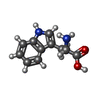 ChemComp-TRP: |
-Macromolecule #5: HISTIDINE
| Macromolecule | Name: HISTIDINE / type: ligand / ID: 5 / Number of copies: 5 / Formula: HIS |
|---|---|
| Molecular weight | Theoretical: 156.162 Da |
| Chemical component information | 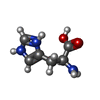 ChemComp-HIS: |
-Macromolecule #6: 2-acetamido-2-deoxy-beta-D-glucopyranose
| Macromolecule | Name: 2-acetamido-2-deoxy-beta-D-glucopyranose / type: ligand / ID: 6 / Number of copies: 5 / Formula: NAG |
|---|---|
| Molecular weight | Theoretical: 221.208 Da |
| Chemical component information |  ChemComp-NAG: |
-Macromolecule #7: (3~{a}~{S})-2-[(3~{S})-1-azabicyclo[2.2.2]octan-3-yl]-3~{a},4,5,6...
| Macromolecule | Name: (3~{a}~{S})-2-[(3~{S})-1-azabicyclo[2.2.2]octan-3-yl]-3~{a},4,5,6-tetrahydro-3~{H}-benzo[de]isoquinolin-1-one type: ligand / ID: 7 / Number of copies: 5 / Formula: O7B |
|---|---|
| Molecular weight | Theoretical: 296.407 Da |
| Chemical component information | 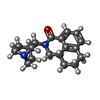 ChemComp-O7B: |
-Experimental details
-Structure determination
| Method | cryo EM |
|---|---|
 Processing Processing | single particle reconstruction |
| Aggregation state | particle |
- Sample preparation
Sample preparation
| Buffer | pH: 7.4 |
|---|---|
| Vitrification | Cryogen name: ETHANE / Chamber humidity: 100 % / Instrument: FEI VITROBOT MARK IV |
- Electron microscopy
Electron microscopy
| Microscope | FEI TITAN KRIOS |
|---|---|
| Image recording | Film or detector model: GATAN K2 SUMMIT (4k x 4k) / Average electron dose: 53.0 e/Å2 |
| Electron beam | Acceleration voltage: 300 kV / Electron source:  FIELD EMISSION GUN FIELD EMISSION GUN |
| Electron optics | Illumination mode: FLOOD BEAM / Imaging mode: BRIGHT FIELD |
| Experimental equipment |  Model: Titan Krios / Image courtesy: FEI Company |
- Image processing
Image processing
| Startup model | Type of model: EMDB MAP EMDB ID: |
|---|---|
| Final reconstruction | Applied symmetry - Point group: C5 (5 fold cyclic) / Resolution.type: BY AUTHOR / Resolution: 2.82 Å / Resolution method: FSC 0.143 CUT-OFF / Software - Name: cryoSPARC (ver. v2.13) / Number images used: 127971 |
| Initial angle assignment | Type: MAXIMUM LIKELIHOOD |
| Final angle assignment | Type: MAXIMUM LIKELIHOOD |
 Movie
Movie Controller
Controller







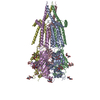
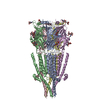
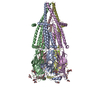


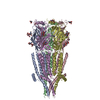



 Z (Sec.)
Z (Sec.) Y (Row.)
Y (Row.) X (Col.)
X (Col.)






















